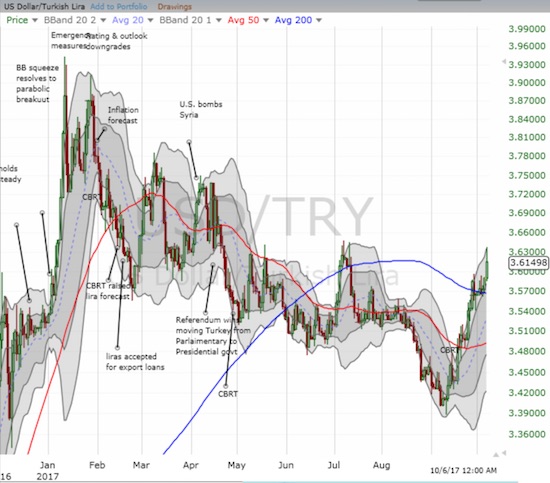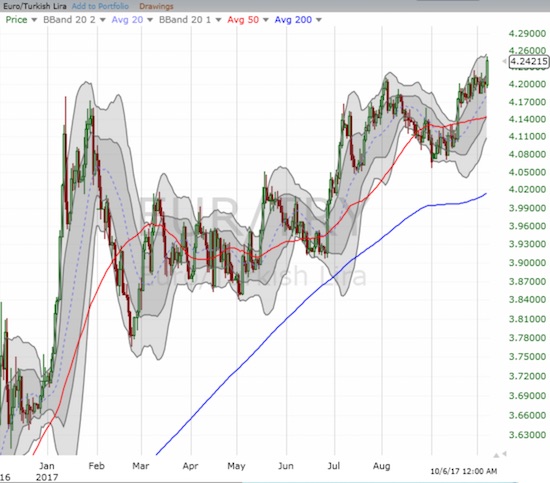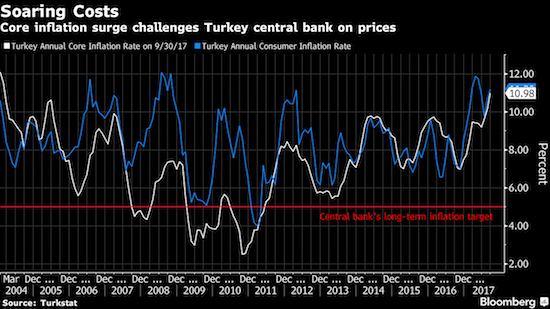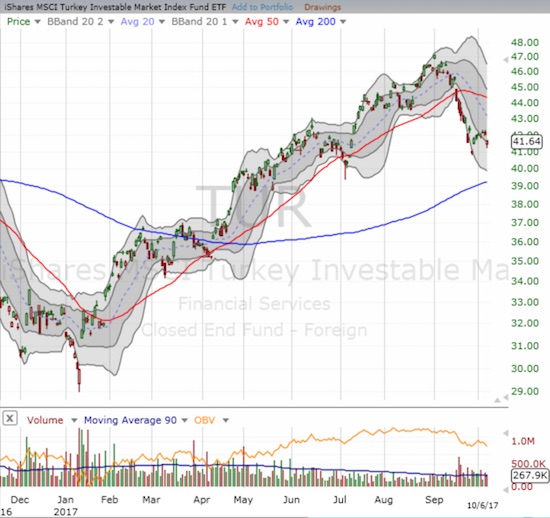The tides are once again turning against the Turkish lira.
For a week, USD/TRY battled with resistance at its 200-day moving average (DMA). Over the last two trading days, the currency pair finally made new closing highs on the 200DMA breakout. USD/TRY faded after testing the highs from the last 200DMA breakout in July.

USD/TRY looks like it broke through the downtrend that has dominated trading all year. Thus, this 200DMA breakout seems ready to resolve differently than July’s which preceded a rapid return to the downtrend.
The changing tide is even more clear against the euro (FXE). EUR/TRY broke out to what I believe is a new all-time high.

Source: FreeStockCharts.com
The latest catalyst came from soaring inflation numbers along with a reminder of Turkish President Recep Tayyip Erdogan’s refusal to acknowledge that inflation must be fought with higher interest rates.
According to Bloomberg, Turkey’s core inflation rate sits at its highest level in about 13 years:
“Core inflation, which excludes volatile items such as food and energy, rose an annual 11 percent through last month, the most since 2004 and outpacing all economists’ estimates in a Bloomberg survey, Turkstat said on Tuesday. The headline inflation rate also exceeded expectations, rising to 11.2 percent.”

Source: Bloomberg
Erdogan chose this moment to reiterate his belief that higher inflation does not need higher interest rates. Again from Bloomberg:
“‘High interest rates will never bring down the inflation rate,’ Erdogan told lawmakers in a televised speech on Tuesday, reviving an unconventional argument he has avoided for several months — but delivered hours after the latest data showed prices are soaring. “The current view is that they are inversely proportional. No, they are not. We have seen this.'”
Of course, looking at the above charts, Erdogan seems to be correct since the Central Bank of the Republic of Turkey (CBRT) hiked rates in late 2016 and took additional measures all to no avail. I think it is more likely the central bank is not doing enough. The question is critical since there is likely nothing more corrosive to the value of a currency than soaring inflation. Given the renewed political tension set up by Erdogan, the CBRT will not likely produce higher rates anytime soon. Under these circumstances, I am no longer looking for entries to play the Turkish lira as a carry trade.
A notable segment of Japanese investors have piled into this carry trade. If a weakening lira sends them covering, the momentum against the lira could sustain for a lot longer. According to Bloomberg, foreign investors in total this year have invested $6.96B in the Turkish lira-denominated bond market. Japanese have rushed into the trade…
“Starved for return by near-zero rates at home, individual investors have propelled a 27 percent jump in Japanese mutual funds’ investments in lira-denominated bonds this year. At 50.8 billion yen ($450 million) through August, it’s poised to be the biggest annual increase since 2012, according to data from Japan’s Investment Trusts Association.”
This foreign investment is important because Turkey’s current-account deficit as a percentage of GDP is one of the largest in the G20. If these investors lose confidence in the ability of Turkey to cap this latest run-up of inflation, the lira’s latest weakness could still be in its early stages.

Source: FreeStockCharts.com
Be careful out there!
Full disclosure: no position
*Charting notes: FreeStockCharts.com uses midnight U.S. Eastern time as the close for currencies. Stock prices are not adjusted for dividends.

Oct 9 update: Turkish lira plunged on political news. Turkey and US have stopped processing VISAs of non-immigrants as part of a growing political spat over Turkey’s desire to extradite Gulen: http://money.cnn.com/2017/10/09/investing/turkey-lira-slumps-dollar/index.html?iid=hp-toplead-intl
I did not consider this as a potential catalyst! I am now finally looking to short the lira but only for quick trades. At the time of writing, USD/TRY has already reversed the majority of its gains. Poor liquidity could be a problem as well, especially with Columbus Day in the U.S.